
“Monsters lead such interesting lives,” according to Bugs Bunny in the Warner short cartoon Hair Raising Hare (1946).
In 1973, The Monster Times, a newspaper devoted to fantasy films, conducted a poll and determined that according to the readers, the top four favorite monsters were Godzilla, Dracula, Frankenstein and King Kong.
These characters and the films in which they appeared were taken very seriously by audiences which made them ripe for parody in animation.
Whether it was Mighty Mouse battling Frankenstein’s Cat (1942) or Porky Pig racing against “Borax Karloff” in Porky’s Road Race (1937) or Gandy Goose watching Dracula and Frankenstein in The Ghost Town (1944) or Woody Woodpecker being transformed into a Frankenstein woodpecker in Monster of Ceremonies (1966), movie monsters have been prominent characters in many classic cartoons.
In addition, in the Golden Age of Saturday morning animation, the monsters inspired programs like Frankenstein Jr., the Groovie Goolies, Milton the Monster, Drak Pack as well as popping up in supporting roles in regular series like The Gruesomes in The Flintstones.
In the past, I have included anecdotes from Universal’s attempt to make a Frankenstein animated feature, 20th Century Fox’s attempt to make a Dracula animated feature directed by Don Bluth and written by Joss Whedon and DePatie-Freleng wanting to do a Saturday morning television series based on King Kong.
My good friend Jerry Beck has convinced me that it would be a “treat” rather than a “trick” to do a special Halloween edition of Animation Anecdotes especially since this Friday is Halloween.
It all started because Jerry and I were having a discussion about the uncredited animation in Abbott and Costello Meet Frankenstein (1948) for the titles and the Dracula transformation.
I had been told decades ago back in Los Angeles by someone who I thought was a reliable source that the animation was most likely done by Walter Lantz and his crew because of their connection with Universal.
Jerry shared with me his thoughts on the matter and I now firmly believe he is as right as anyone can be with what little documentation there is out there.
Jerry wrote:
“If Lantz did those titles I’m surprised more physical “evidence” hasn’t arisen in all these years. Much Lantz production material survives in the Lantz Archives at UCLA… especially from that time, especially on commercial projects (Destination Moon, Coke Commercials, etc.).
“Lantz was NOT involved with Universal at that time. His cartoons were being distributed by United Artists in 1948! Abbott and Costello Meets Frankenstein was filmed in February and March 1948 and released in June 1948. The main titles would have been done during that time frame… Lantz did not resume his relationship with Universal till sometime in 1950.
“I found some information in the Asifa Hollywood archives that details what Dave Fleischer did for Universal. After 1945, he was responsible for producing animation for titles, trailers, shorts for that studio. He was apparently there for over 20 years!
“While I don’t have ‘smoking gun’ evidence that Dave was involved and produced the A&C Frankenstein titles, I have lots of invoices that show he did similar chores on dozens of Universal projects during that era. He often employed Howard Swift’s independent animation studio during this time to do the art work.”
I am a huge fan of Abbott and Costello Meet Frankenstein. I have a Xerox of the original shooting script when it was called “The Brain of Frankenstein”, a photocopy of the Showman’s Manual that talks about the puppet bat hurtling through the air “in eerie fashion by compressed air”, and more but there is no discussion whatsoever anywhere about that wonderful animation. Do you know something that you can add to the discussion?
In the spirit of Halloween and to thank Mr. Beck for his decades long friendship, here are some monster animation anecdotes to celebrate the holiday.
Hopefully, this will also serve as a reminder that no matter how many times these monsters have been defeated that they are truly indestructible and merely awaiting an enterprising animation studio to once again unleash them on an unsuspecting world.
The First Time. The first recognizable caricatures of the classic Universal monsters appeared in Mickey’s Gala Premiere (1933). Betty Boop’s Penthouse (1933) had featured a Frankenstein-like monster attacking a sunbathing Betty and Bosco had a robot named “Frankensteen” in Mechanical Man (1933).
In Mickey’s world, the monsters were not menacing threats but merely working performers like the rest of the caricatured movie stars enjoying the debut of Mickey’s latest cartoon. That’s Bela Lugosi’s Dracula sitting next to Fredric March’s interpretation of Mr. Hyde, the “worser” half of the infamous Dr. Jekyll. That creature is often misidentified as “the wolfman” (who wouldn’t appear until 1941).
The sequence was animated by Art Babbitt who was obviously using a reference photo of an early proposed (and discarded) makeup test for Boris Karloff which explains the odd “horns” on the forehead. Babbitt also removed the round bolts on the neck and replaced them with clamps and a curling electrical wire.

Art Babbitt animation (above) and early makeup test of Karloff (below)
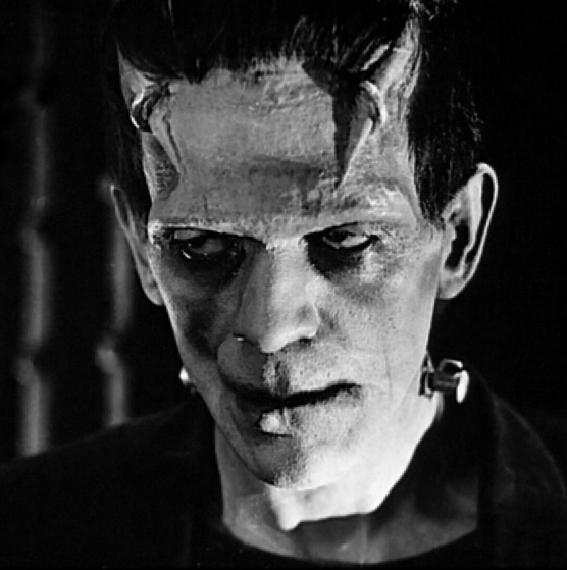
 Tomb of Dracula. In 1980, a roughly ninety-minute anime television movie based on the Marvel comic book series (1972-1979) The Tomb of Dracula by Marv Wolfman and Gene Colan was released. Ironically, the comic book series itself was not available in Japan at the time.
Tomb of Dracula. In 1980, a roughly ninety-minute anime television movie based on the Marvel comic book series (1972-1979) The Tomb of Dracula by Marv Wolfman and Gene Colan was released. Ironically, the comic book series itself was not available in Japan at the time.
The film was called Yami no Teiō: Kyūketsuki Dorakyura (Emperor of Darkness: Vampire Dracula). Much of the main plot came from the long running (seventy plus issues) comic book series. Of course, it was condensed and many characters (like Blade, Hannibal King and Deacon Frost among others) and subplots were omitted.
 Basically, in contemporary Boston, Dracula invades a Satanic ritual, making off with the intended beautiful female sacrifice. Instead of draining her blood, Dracula falls in love with her and fathers a child. This action makes Dracula the target for both a team of vampire hunters including wheel-chair bound Hans Harker (called “Quincy” in the comics) but also the Satanists. For his actions, Satan has stripped Dracula of his vampire powers and he must find a vampire to restore him so he can do battle against his foes.
Basically, in contemporary Boston, Dracula invades a Satanic ritual, making off with the intended beautiful female sacrifice. Instead of draining her blood, Dracula falls in love with her and fathers a child. This action makes Dracula the target for both a team of vampire hunters including wheel-chair bound Hans Harker (called “Quincy” in the comics) but also the Satanists. For his actions, Satan has stripped Dracula of his vampire powers and he must find a vampire to restore him so he can do battle against his foes.
The film was animated in Japan by Toei (who had done the 1978 live-action Japanese Spider-man television series). It was part of a deal that also included producing the animated feature The Monster of Frankenstein (1981), based on another Marvel horror comic book series. This film is offically the very first Marvel animated feature.
The film was released on cable TV in North America in 1983 by Harmony Gold that dubbed it into English (with voice direction by Robert Barron who used many actors who would later appear in Robotech) and called Dracula: Sovereign of the Damned. It was also released on both Betamax and VHS!
The violence and a brief glimpse of female nudity in the shower did not make it appropriate viewing for young audiences. It universally received poor reviews from American anime fans.
King Kong and Disney. Disney parodied the popular live action movie King Kong (1933). The film was released on March 2 and by October 28, Disney had in theaters the Mickey Mouse short The Pet Store. Beppo, the “Movie Monk”, reads a movie magazine featuring a real ad for the classic film and decides to imitate the gigantic ape including scaling a building of boxes.
At this time, Walt was in discussions with Kong’s director Merian C. Cooper about developing a full-length animated feature of Babes in Toyland, several years before embarking on Snow White and the Seven Dwarfs (1937).
However, Disney was beaten to the punch of being the first animated parody by Walter Lantz who released King Klunk (1933) September 4 where Pooch the Pup and his girlfriend journey to Africa to take movies of the famous ape with the rest of the plot following the story of the original film.
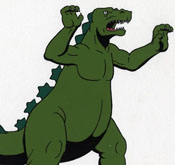 Godzilla the Great Ape. Hanna-Barbera character designer Doug Wildey loved telling the story of how frustrated he was designing the main character for the 1978 Saturday morning television show, The Godzilla Power Hour. His first designs were immediately rejected by Japan’s Toho studio because Godzilla’s face did not look “ape-like” enough.
Godzilla the Great Ape. Hanna-Barbera character designer Doug Wildey loved telling the story of how frustrated he was designing the main character for the 1978 Saturday morning television show, The Godzilla Power Hour. His first designs were immediately rejected by Japan’s Toho studio because Godzilla’s face did not look “ape-like” enough.
Godzilla’s Japanese name was “Gojira” which was taken from the U.S. word for “gorilla” (to suggest King Kong) and the Japanese word for a whale, “kujira”. Wildey had tried to make Godzilla look more like a dinosaur or a reptilian dragon because of the flame breath. As soon as he made the face more ape-like, the design was accepted.
Frazetta’s Animated Dracula. In 1975, famed illustrator Frank Frazetta was commissioned by Orsatti Productions to design characters for an animated feature film adaptation of Bram Stoker’s Dracula that was never made. Here are a few of the concept sketches of The Count himself done in watercolor and pencil.
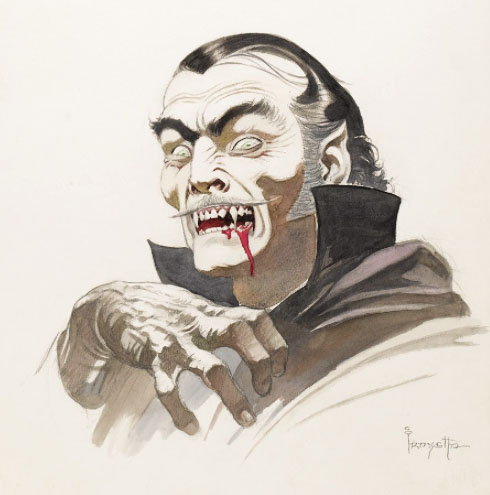
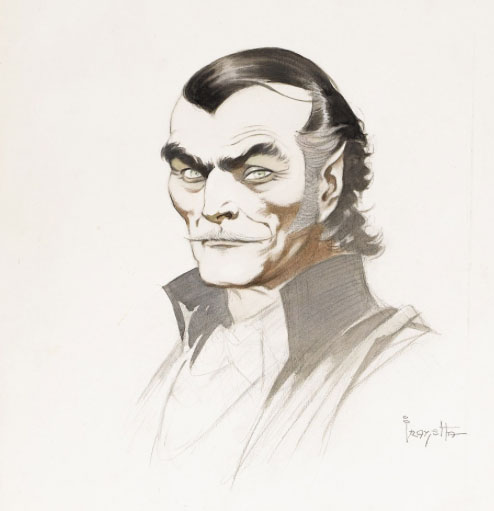
Andrew Carmonte was listed as director with Emil Carle producing and George Greer doing the scripting for what was to be a faithful adaptation of the famous horror novel. Apparently there was no money for the project and hiring Frazetta to produce concept art was to help interest potential investors.
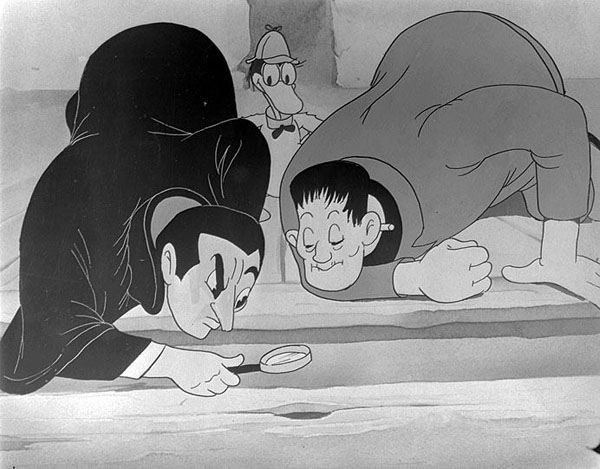
Gandy Goose encounters Dracula and Frankenstein in “G-Man Jitters” (1939)


 Jim Korkis is an internationally respected animation historian who in recent years has devoted his attention to the many worlds of Disney. He was a columnist for a variety of animation magazines. With his former writing partner, John Cawley, he authored several animation related books including The Encyclopedia of Cartoon Superstars, How to Create Animation, Cartoon Confidential and Get Animated’s Animation Art Buyer’s Guide. He taught animation classes at the Disney Institute in Florida as well as instructing classes on acting and animation history for Disney Feature Animation: Florida.
Jim Korkis is an internationally respected animation historian who in recent years has devoted his attention to the many worlds of Disney. He was a columnist for a variety of animation magazines. With his former writing partner, John Cawley, he authored several animation related books including The Encyclopedia of Cartoon Superstars, How to Create Animation, Cartoon Confidential and Get Animated’s Animation Art Buyer’s Guide. He taught animation classes at the Disney Institute in Florida as well as instructing classes on acting and animation history for Disney Feature Animation: Florida.




















































Great post! One minor correction… don’t believe Gandy and Sourpuss met Frank and Drac in GHOST TOWN. That one was set in a Western-type ghost town.
I must admit it has been some time since I saw the cartoon THE GHOST TOWN and I know there is some controversy about whether Frankenstein and Dracula appeared in the short so I relied on THE DRACULA BOOK by authority Don Glut (Scarecrow Press 1975) on page 239: “Paul Terry’s Terrytoons first presented a cartoon Dracula in a Gandy Goose short subject, THE GHOST TOWN, directed by Mannie Davis. A vampire bat leads the obedient Frankenstein Monster before Gandy and transforms into the human form of Count Dracula. “He knows too much,” Dracula says profoundly. Gandy then goes into hysterics and awakens from his nightmare.” So while the cartoon did take place in an Old West town, it was all…as has often been said many times….all a dream! At least when it came to Frankenstein and Dracula.
Whoa, Jim! There’s a controversy over THE GHOST TOWN? Some lost footage clipped from the original? Never heard that. I do know there’s nary a glimpse of Dracula nor Frankenstein in the TV prints (I have one) and there’s nothing like the ‘it’s all a dream’ ending Don Glut describes… the finale actually has our heroes being chased off into the distance by a ravenous ghost-vulture. With all due respect, I think it’s more likely Mr. G. just got a little mixed up with his Gandies. G-MAN JITTERS has some (not all) of the details he mentions.
Ironically, the comic book series itself was not available in Japan at the time.
And yet it didn’t stop them from assuming Dracula would chow down on burgers in diners at night!
http://www.misterkitty.org/extras/stupidcovers/stupidcomics282.html
The film was released on cable TV in North America in 1983 by Harmony Gold that dubbed it into English (with voice direction by Robert Barron who used many actors who would later appear in Robotech) and called Dracula: Sovereign of the Damned. It was also released on both Betamax and VHS!
Not bad for something that could’ve lavished in obscure hell for eternity. Harmony Gold also dubbed a few other of Toei’s TV movies produced around the same time like “Little Women”, “An Olympic Fable: Run For Life”, Jack London’s “Call of the Wild” (possibly the most graphically violent cartoon you could ever show your child) and one of the Galaxy Express 999 TV films (I think it’s “Can You Love Like A Mother?”).
The violence and a brief glimpse of female nudity in the shower did not make it appropriate viewing for young audiences. It universally received poor reviews from American anime fans.
If those same parents already bought/rented “Ringing Bell” for their kids, they’ll get use to it!
Godzilla’s Japanese name was “Gojira” which was taken from the U.S. word for “gorilla” (to suggest King Kong) and the Japanese word for a whale, “kujira”. Wildey had tried to make Godzilla look more like a dinosaur or a reptilian dragon because of the flame breath. As soon as he made the face more ape-like, the design was accepted.
You have to be faithful, there’s no way around it!
That was an interesing post, particularly with the footnotes about the first Universal Horror caricutures and Frazetta’s stunning artwork for that unfinished film project. A fine piece of film history to keep me educated on Halloween night.
The silhouetted movement of “Lenore Aubert” in the A&C title sequence reminds me of the light-skinned girl in “Scrub Me Mama With A Boogie Beat” (Lantz-Universal, 1941).
Not to overlook Frankenstein/Boris Karloff’s out-of-season appearance in Walter Lantz’s early color Christmas cartoon, TOYLAND PREMIERE. Another Hollywood-star caricature picture, this includes Laurel and Hardy, Bing Crosby, Shirley Temple, Johnny Weissmuller (as Tarzan) with his then-wife Lupe Velez, and Eddie Cantor (in blackface and so usually misidentified as Al Jolson…THANKS to Dave Kirwan, a superfan of Cantor, for the correct ID) as well as Karloff’s monster.
Stan and Ollie try to swipe the party cake, Frankenstein scares them off by brandishing a butter knife and shouting “SCRAM!!” Needless to say, they don’t give up that easily; and in the final sequence Lupe Velez (!) gets the best gag, which I’m not going to spoil for those who haven’t seen it. By the way, Frankenstein is shown in color with blue-greenish skin, which I believe may have reflected the makeup worn by Karloff in the b/w movie.
Oh, and let’s not forget Universal used delightful animated titles for Abbott and Costello’s HOLD THAT GHOST, released years earlier.
Almost forgot Woody Woodpecker in FRANKEN-STYMIED, trying to outsmart Dr. F’s latest invention, “a mechanical chicken plucker,” with Paul Frees doing his Peter Lorre voice as the mad scientist. A year or two ago, FRANKENSTEIN’S CAT got an unexpectedy huge laugh at a Sons of the Desert (Laurel & Hardy club) screening when Mighty Mouse confronted said cat and asked in a Leo Gorcey-ish “Noo Yawk” tough-mug voice, “What did youse do wit’ da boid??” And of course, there’s Rankin-Bass’s version of KING KONG (designed by Jack Davis, though you might not guess from the Japanese animation) and Marv Newland’s BAMBI MEETS GODZILLA!
I wouldn’t consider “Bambi Meets Godzilla” in the same camp if only due to being a parody otherwise, but each his/her own I guess.